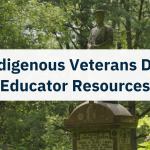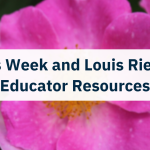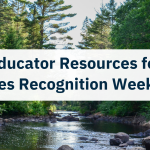Outdoor Education and Land-Based Learning
As the weather gets warmer and the days get longer, everyone starts itching to get outside and enjoy the fresh spring days. Many teachers find it challenging to keep students still and focused at this time of year. In fact, some teachers may even be experiencing the same wistful longing to be outside as their students!
Why not embrace students’ desire to be outside? Outdoor education has many positive benefits for students, from reducing stress to increasing engagement in the classroom after learning outdoors.
What’s the Difference Between Outdoor Education and Indigenous Land-Based Learning?
“Outdoor education” and “land-based learning” are umbrella terms encompassing many ways to engage students outside. From teaching a class outside to having students identify leaves in various stages of decomposition to using natural materials for an art project, there are many ways to bring outdoor learning into your classroom.
Outdoor education is at one end of the spectrum, focusing on doing activities outside. Activity-focused outdoor learning is incredibly beneficial for students. Studies have shown that outdoor teaching increases students’ interest in a subject and intrinsic motivation to learn. It also improves students’ ability to pay attention and helps them retain information for longer.
While Indigenous land-based learning programs look similar to outdoor education programs, they are much more than taking a class outdoors. Dr. Amy Parent from Nisga’a Nation states, “Indigenous land-based education is a process that centres respect, reciprocity, reverence, humility and responsibility as values connected to the land through Indigenous knowledges.” While many outdoor education programs recognize the deep connection to land that is part of Indigenous cultures, each program is unique, and some might not focus on Indigenous knowledge.
Outdoor education and land-based learning are similar in their experiential nature, their ability to foster respect for the environment, their capacity for skill development, and the benefits they offer to health and well-being.
Indigenous Land-Based Learning
Since Indigenous land-based learning is rooted in specific languages, cultures, and geographies, each program will be as unique and different as the Nation or education group offering it. Though each program will reflect different types of Indigenous knowledge, they are all typically rooted in the values of responsibility, respect, relationality, and reciprocity, also known as the Four Rs. This framework was articulated by renowned Indigenous scholars Verna J. Kirkness and Ray Barnhardt to help educators understand how to decolonize their teaching.
Indigenous land-based learning “brings together layered concepts like the importance of language and the geography of stories, cosmologies and world views, land protections and rights, relationality and accountability, and a connection to reconciliation.” Another significant characteristic of these programs is that they bring Elders and youth together so Elders can pass on their specific cultural knowledge.
Indigenous land-based learning is uniquely positioned to be transformational for all Canadians. Learning about the land from Indigenous perspectives allows us to move from a Eurocentric “land as resource” mentality to one that encourages people to develop a relationship with the land that centres the Four Rs of responsibility, respect, relationality, and reciprocity.
Incorporating Outdoor Education & Land-Based Learning
There are meaningful differences between outdoor education and land-based learning. It’s beneficial for educators and students to understand these differences and participate in both types of programs depending on the resources available to them.
Educators often feel the need to balance curriculum expectations with fun activities, but a nature walk can do both without compromising. Read the activity below and see how many curriculum connections and opportunities you can create!
Nature Walk
Prepare for the nature walk by having students brainstorm what they will need. Have your students consider the weather conditions and decide what clothing they will need, like rain gear, warm socks, and additional layers in case the weather changes suddenly.
Once you’re outside, have your students explore! As they walk, encourage them to search for animal tracks or homes. Are there new plants sprouting from the ground? Are there mushrooms growing on any stumps or logs? Have them draw pictures and record their observations.
Before returning to the classroom, stop to rest in a safe spot and enjoy the sights and sounds of nature.
Journaling
Encourage students to record their experiences outside and journal about their observations, experiences, or feelings. What has the land done for them? How has the land changed over time? How has their relationship with the land changed? Give students choice in how they record their thoughts. For example, students could write in a journal, record a video, or draw pictures.
Reflection
When you return to the classroom, continue your outdoor learning by having students reflect on their experience. Ask them how they felt during the nature walk and invite them to share their observations and reflections. Find news articles or stories about nature, and have students consider why nature is important, why we should respect the land, and how we can take care of it.
Nature in the Classroom
While the nature walk might be a highlight for educators and students alike, it’s not always possible to bring students outside. Instead, you can try bringing nature inside. For example, you could have students grow plants from seeds and chart the stages of growth or have students draw or sketch natural objects.
Storytelling
Land-based learning involves a deep connection with the land and all living things. Indigenous cultures often connect and teach these lessons through stories. If possible, invite Knowledge Keepers into the classroom to share stories about their understanding of nature and their relationship to the land.
Connecting land-based learning with stories by Indigenous authors is a great way to bring the learning outdoors back inside the classroom and vice versa. The First Nations Education Steering Committee has an annotated list of resources for students in grades K–12. Novel studies, short stories, poetry, and informational texts can all become bridges between the classroom and the outdoors.
Get Creative!
These are only a few ideas for incorporating outdoor or land-based learning into your classroom. Scale or adapt these ideas based on your own experience and the resources available to you.
Do you have other ideas for incorporating outdoor learning? We’d love to hear from you! Please email us and share your experiences.
Sources
Kirkness, V. J., R. Barnhardt (2001). First Nations and higher education: The four R’s – Respect, relevance, reciprocity, responsibility. In R. Hayoe and J. Pan (Eds.), Knowledge across cultures: A contribution to dialogue among civilizations. Comparative Education Research Centre, University of Hong Kong. https://www.uaf.edu/ankn/publications/collective-works-of-ray-b/Four-Rs-2nd-Ed.pdf






